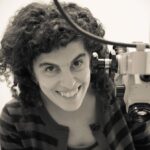
Menu
Symposia
Wed 20 | 14:00 - 16:00
How does the brain represent what we know (and don’t know) about the world?
Chairs
The computations involved in perception, reflections about the world, and action planning, are not performed on external stimuli, but rather on our internal representations of those stimuli. Therefore, the aspects of reality our sensory systems happen to represent, and the specific way in which those representations are instantiated in a neural code, fundamentally constrain the way we experience and interpret the world. Moreover, several neuropsychiatric disorders are presently postulated to result from an anomalous representational structure. This symposium summons four neuroscientists with computational background to discuss the structure of representations of different aspects of the physical world, such as our location in space, the orientation and color of visual stimuli, and the temporal structure of vocal productions. Specific emphasis is made on the geometric structure that the neural code imparts on the represented space, on the encoding of the degree of uncertainty about the represented stimulus, and on the relevance of the temporal structure of the code. The purpose is to employ computational tools to characterize the biases, capacities and limitations of the so-called “eye of the beholder” as a first step in our understanding of both typical and atypical phenomenal experience.
Speakers

Neural coding of sound envelope structure in songbirds
Ana Amador
Dept. of Physics, University of Buenos Aires and IFIBA, CONICET, ARGENTINA
Read More
Songbirds are a well-established animal model to study the neural basis of learning, perception and production of complex vocalizations. In this system, telencephalic units in the neural nucleus HVC present a state-dependent, highly selective response to auditory presentations of the bird’s own song (BOS). This property provides an opportunity to study the neural code behind a complex behavior. Here, I will show that subtle changes in the temporal structure of the sound envelope of the song can drive changes in the neural responses of highly selective HVC units. In this work, we generated an envelope-modified BOS (MOD) by reversing each syllable’s envelope but leaving the overall temporal structure of syllable spectra unchanged, which resulted in a subtle modification for each song syllable. We conducted in vivo electrophysiological recordings of HVC neurons in anaesthetized zebra finches (Taeniopygia guttata). Units analyzed presented a high BOS selectivity and lower response to MOD, but preserved the profile response shape. These results show that the temporal evolution of the sound envelope has a specific neural representation in the avian song system.

A bridge between physiological and perceptual views of autism by means of sampling-based Bayesian inference
Rodrigo Echeveste
sinc(i), CONICET-UNL
Read More
Theories for autism spectrum disorder (ASD) have been formulated at different levels: ranging from physiological observations to perceptual and behavioural descriptions. Understanding the physiological underpinnings of perceptual traits in ASD remains a significant challenge in the field. Here we studied the link between Bayesian computations under weakened priors, and inhibitory dysfunctions, neural variability, and oscillations in ASD subjects. We worked with a recurrent neural-network (RNN) model which had been trained to perform inference in a visual task via sampling. We took two parallel paths: In one of them, we modified the probabilistic generative model under which the stimuli are assumed to be generated in order to increase the uncertainty of the prior distribution. In the other, we weakened the inhibitory connections in the neural network to induce an inhibitory dysfunction. We found that both paths lead to consistent results in terms of the represented posterior distributions, providing support for the view that both descriptions might constitute two sides of the same coin. Furthermore, the dynamical properties of the network performing Bayesian inference allowed us to make connections between probabilistic computations and previous observations in terms of neural variability, oscillations and transient responses in the ASD population.

The geometry of color space
Ines Samengo
Department of Medical Physics, Centro Atómico Bariloche and Instituto Balseiro
Read More
Our sensory systems transform external signals into neural activity, from which percepts are produced. We are endowed with an intuitive notion of similarity between percepts, that need not reflect the proximity of the physical properties of the corresponding external stimuli. The quantitative characterization of the geometry of percepts is therefore an endeavour that must be accomplished behaviorally. Here we characterized the geometry of color space using discrimination experiments. We proposed an individually tailored metric defined in terms of the minimal chromatic difference required for each observer to differentiate a stimulus from its surround. Additional discrimination and matching experiments demonstrated that the metric derived from the first experiment revealed perceptual chromatic effects to be remarkably homogeneous and isotropic throughout color space. We conclude that adequately capturing the geometry of color space reveals the natural symmetries of the computations involved in phenomenology of color perception.

Network architecture shapes spatial representations in the medial entorhinal cortex ... Or does it?
Emilio Kropff
Leloir Institute - IIBBA
Read More
Entorhinal grid cells have a population activity with striking hexagonal spatial periodicity, a torus in topological terms. This is considered to be possible only as a consequence of the architecture of connections being itself a torus, constraining through attractor dynamics the possible activity states of the network. In more general terms, the word ‘dimensionality’ referring to an attractor network is used indistinctly to speak about the architecture of connections and the space of representations. Here we present for the first time evidence showing that the architecture of an attractor network and the space of representations can be two distinct topological objects. In a model of grid map formation resulting from self-organized Hebbian learning, we assessed the consequence of adding an architecture of recurrent connections representing a torus (2D) or a ring (1D). We found that both networks have the ability to align all maps to a common set of hexagonal axes, so that population activity is constrained to a torus. The ring architecture, however, is more flexible, generating a family of solutions, which is appealing since grid cells are capable of coding for 1D variables (e.g. time).
Our work shows for the first time that the architecture of the grid cell network could be something other than an ad hoc 2D object. It also provides a counterexample against the prevailing intuition that the architecture of a network and the space of representations must go hand in hand.

